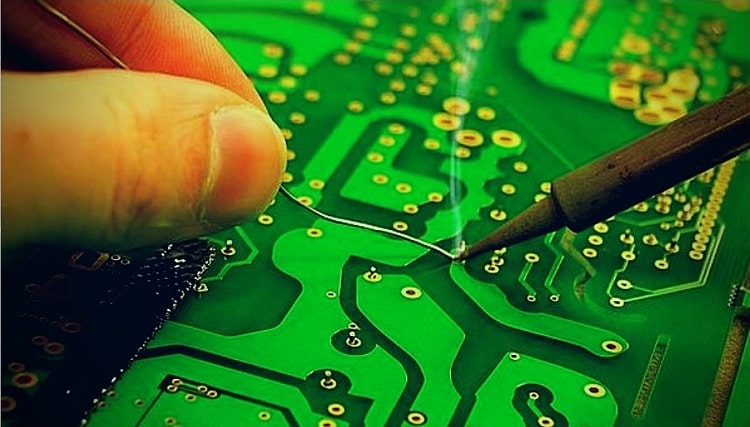Those who know about electronics will tell you that the Printed Circuit Board is something very common.
A PCB uses copper sheets laminated to a second non-conductive material.
The benefit of a PCB is that you are using pre-defined tracks. These pre-defined tracks reduce the amount of wiring used, and in turn, leads to a reduction in faulty connections.
This article will instruct you on how to make your own PCB. You won't require any special materials for a DIY PCB board, with everything being kept as simple as possible
Contents
How to Make a Printed Circuit Board (PCB)

A. Methods For Making A PCB
- Laser Cutting Edge Etching
- Iron-On Glossy Paper
- Circuit by hand on PCB
In this article, we won't be talking about Laser Cutting Edge Etching. This industrial method cannot be used for making PCB at home.
B. Software Packages
You will need to download PCB layout software to assist you with PCB creation.
Popular software includes:
- PCB Wizard
- Autodesk Eagle
- Cadsoft Eagle
C. Step By Step Guide To Making A PCB
You will require:
- Acetone
- Blade cutter
- Copper Clad Laminate
- Cotton Wool
- Etching Solution
- Etching Solution (Ferric Chloride Powder)
- Iron (Household)
- Kitchen Scrubs
- Laser Printer
- Paper Kitchen Towels
- Permanent Marker (Black)
- Photo Paper (A4)
- Plastic coated wire
- Sandpaper
STEP 1: Design Your PCB
Using any of the software we mentioned previously, design your PCB. Remember, when exporting your design for printing, set the DPI to 1200.
STEP 2: Print
Using a laser printer and some photo paper (A4), print the PCB layout.
Remember:
- The image should be a 'mirror' print.
- In both the software and on the printer, settings should be set to black.
- Print on the glossy side of the photo paper
STEP 3: Cut Your Copper Plate
The copper plate will be used for the circuit board.
Using a cutter, get it cut to the size required for your design.
STEP 4: Sand the Copper Plate
Using sandpaper or steel wool, if you have it, rub the copper plate. This sanding will remove the layer of oxide from the plate and the photoresist layer.
Sanding the surface will also mean the image you will use sticks to the copper more effectively.
STEP 5: Prepare To Transfer PCB Print (Iron-On Glossy Paper Method)
Use this method if you have a circuit with a hard degree of complexity.
Take your printed image, and transfer this to the copper board.
To do this, take the top layer of the paper needs to be flipped horizontally. Once flipped, place the copper surface on the printed layout. Ensure that you have correct alignment, and once you have decided everything is aligned, tape the board and paper, so they remain in the correct position.
ALTERNATIVE STEP 5: Circuit by Hand on PCB
You can use this method for circuits you are comfortable sketching by hand.
First, use a pencil to sketch out your circuit. Once you are happy, go over it with a black permanent marker.
If using this method, you can move straight on to Step 9.
STEP 6: Iron
Now, you will iron the printed image onto the copper plate. To do this, you will need to set the iron to the maximum possible temperature.
You can use an ironing table for this job or place a towel on another surface and iron that way. Just make sure the surface is stable.
Before starting the ironing process, ensure the back of the photo paper is facing you.
You will need a pair of pliers or a similar implement to hold the copper plate steady. Once you have these, hold one end of the plate with the pliers and then place the hot iron on the other end. Keep it there for 10 seconds.
After this initial burst of heart, you will use the tip of the iron to iron the entire photo paper for between 5 to 15 minutes.
When doing this, ensure you apply pressure and iron slowly. Do not forget to iron the edges.
This process transfers the ink from the photo paper onto the copper plate.
WARNING: Do not touch the copper plate. It will burn you.
STEP 7: Cool Down Plate
Take some lukewarm water and put the copper plate into it. Keep it there for 10 minutes. After 10 minutes, remove the plate from the water and gently remove the remaining glossy/photo paper.
STEP 8: Darken Faint Lines
Some of the lines (tracks) created may be a bit too light for your liking. Use a black permanent marker to darken these.
STEP 9: Etch the Copper Plate
WARNING: Wear some protective gloves when doing this (rubber or plastic), and protect the surrounding area with newspaper to avoid getting etching solution on any surfaces.
You will need a plastic box filled with water. In this water, dissolve 2 to 3 teaspoons of Ferric Chloride Powder.
Once the Ferric Chloride Powder is dissolved, let the copper plate rest in the solution for thirty minutes.
This ferric chloride solution will react with the copper that is not masked by your design, removing the extra copper.
After 30 minutes, use your pliers to remove the copper plate. Check if the entire area has been etched. If not, place the plate back in the solution, regularly checking until the etching is fully done.
STEP 10: Disposing Of the Etching Solution
The etching solution is highly toxic. It can kill animals and destroy your pipes. Therefore, please do not throw it down the sink.
Dilute the solution as much as possible, then dispose of it in a safe manner.
STEP 11: Expose the Remaining Copper
Under the design you inked to the plate, copper remains. To expose this, use a thinner on some cotton wool. This will remove any toner or ink.
Give the PCB a gentle rinse, and dry it with the kitchen paper.
Once dry, trim the PCB down, and smooth any rough edges with your remaining sandpaper.
STEP 12: Finishing Touches
Drill any holes you need using a PCB drill, and then solder your components to the PCB. Your PCB is now ready to use!
Conclusion
Two methods can be used for making a PCB at home.
The hand-drawn method is fine when the circuits are simple, but for anything more complex, you should use the iron-on glossy paper method.
Finally, don't forget to dispose of the etching solution safely to avoid doing permanent damage.




